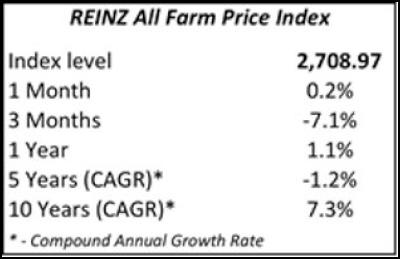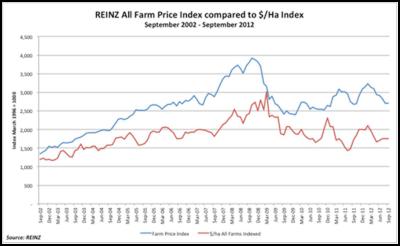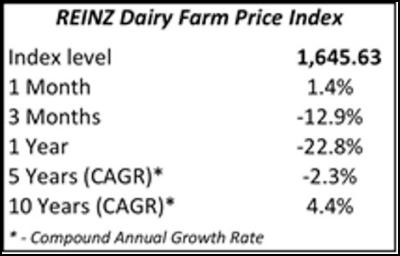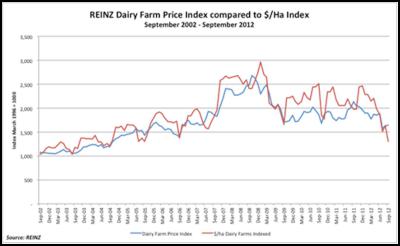Unsettled Conditions Create Slower Early Spring Rural Real
News Release 11 October
2012
Unsettled Conditions Create
Slower Early Spring
Rural Real Estate
Market
Summary
• Sales
up 5 per cent year on year
• Median $/ha price
rose 2 percent compared to September 2011
• REINZ All Farm Price Index and REINZ Dairy
Farm Price Index both rose in
September
• Shortage of listings emerging as a
serious constraint for buyers
Data released today by the Real Estate Institute of NZ (“REINZ”) shows there were 11 more farm sales (+4.7%) for the three months ended September 2012 than for the three months ended September 2011. Overall, there were 269 farm sales in the three months to end of September 2012, compared with 318 farm sales in the three months to August 2012, a decrease of 49 sales (-15.4%). 1,425 farms were sold in the year to September 2012, 35.3% more than were sold in the year to August 2011.
The median price per hectare for all farms sold in the three months to September 2012 was $18,041; a 2.0% increase on the $17,694 recorded for three months ended September 2011. The median price per hectare increased by 0.5% compared to August 2012.
The REINZ All Farm Price Index rose by 0.2% in the three months to September compared to the three months to August, from 2,702.8 to 2,708.97. Compared to September 2011 the REINZ All Farm Price Index increased by 1.1%. Further details on the REINZ All Farm Price Index are set out below.
Six regions recorded increases in sales volumes for the three months ended September 2012 compared to the three months ended September 2011. Canterbury recorded the largest increase in sales (+22 sales), followed by Auckland (+21 sales) and Nelson (+12 sales). Wellington recorded 11 fewer sales followed by Southland and Manawatu/Wanganui (-10 sales) and Northland (-7 sales) in the three months to September 2012 compared to the three months to September 2011. Compared to the three months ended August 2012 only three regions recorded an increase in sales, lead by Auckland (+8 sales).
“Unsettled weather and market conditions have put a dampener on the early spring rural real estate market,” says REINZ Rural Market Spokesman Brian Peacocke. “Cold, wet conditions have impacted on feed supplies and production resulting in increased ‘on farm’ stress.”
“We are seeing strong demand for quality dairy and larger sheep and beef farms, but the shortage of listings is a serious constraint on buyers. Whilst we are expecting more properties to come to market during October and November, the anticipated increase is unlikely to be sufficient to meet the increasing demand.”
Grazing properties accounted for the largest number of sales with 52.0% share of all sales over the three months. Finishing properties accounted for 16.7%, with Horticulture properties accounting for 13.8% and Special properties 5.2% of all sales. These four property types accounted for 87.7% of all sales during the three months ended September 2012.
Dairy
Farms
For the three months ended September
the median sales price per hectare for dairy farms was
$19,604 (9 properties), compared to $24,492 for the three
months ended August 2012 (21 properties), and $29,668 (19
properties) for the three months ended September 2011. The
median dairy farm size for the three months ended August
2012 was 256 hectares.
Included in sales for the month of September were two dairy farms at a median sale value of $33,992 per hectare. The median farm size was 159 hectares with a range of 139 hectares in the Waikato to 178 hectares in Canterbury. The median production per hectare across all dairy farms sold in September 2012 was 1,026kgs of milk solids.
The REINZ Dairy Farm Price Index rose by 1.4% in the three months to September compared to the three months to August, from 1,622.87 to 1,645.63. Compared to September 2011 the REINZ Dairy Farm Price Index fell by 22.8%. Further details on the REINZ Dairy Farm Price Index are set out below.
Finishing
Farms
For the three months ended September
2012 the median sales price per hectare for finishing farms
was $22,468 (45 properties), compared to $20,941 for the
three months ended August (56 properties), and $18,735 (36
properties) for the three months ended September 2011. The
median finishing farm size for the three months ended
September 2012 was 53 hectares.
Grazing Farms
For the three months ended September 2012
the median sales price per hectare for grazing farms was
$11,444 (140 properties) compared to $11,297 for the three
months ended August 2012 (159 properties), and $12,330 (144
properties) for the three months ended September 2011. The
median grazing farm size for the three months ended
September 2012 was 89 hectares.
Horticulture
Farms
For the three months ended September
2012 the median sales price per hectare for horticulture
farms was $141,968 (37 properties) compared to $130,000 (41
properties) for the three months ended August 2012, and
$82,000 (19 properties) for the three months ended September
2011. The median horticulture farm size for the three
months ended September 2012 was five
hectares.
Lifestyle Properties
The lifestyle property market saw a 6.2% increase in sales volume in the three months to September 2012 compared to September 2011. 1,339 sales were recorded in the three months to September 2012 compared to 1,261 sales in the three months to September 2011. 48 fewer sales were recorded compared to the three months to August 2012 (-3.5%).
Just two regions recorded increases in sales compared to August while 11 recorded decreases. Hawkes Bay recorded the largest increase (+3 sales), followed by Taranaki (+2 sales). Wellington recorded the largest fall in sales (-10 sales), followed Auckland and Bay of Plenty (both -9 sales). Compared to September 2011 eight regions recorded increases in sales with six regions recorded decreases.
The national median price for lifestyle blocks eased by $5,000 (-1.1%) from $455,000 for the three months to August 2012 to $450,000 for the three months to September 2012. Compared to three months to September 2011 the median price rose by $20,000 (+4.7%).
The number of days to sell for lifestyle properties improved by seven days, from 88 days for the three months to the end of August to 81 days for the three months to the end of September. Compared to the three months ended September 2011 the number of days to sell improved by 26 days from 107 days to 81 days. West Coast recorded the shortest number of days to sell in September at 48 days, followed by Canterbury at 49 days and Gisborne at 52 days. Otago recorded the longest number of days to sell at 178 days, followed by Hawkes Bay at 127 days and Nelson at 125 days.
Commenting on the lifestyle property market statistics Brian Peacocke said, “There has been a greater depth of localised activity near Auckland, and the steady market in the Waikato continues to benefit from buyer enquiry from outside the region. Marlborough is also benefitting from strong enquiry, and whilst there has been a slight increase in activity in Canterbury, slow insurance payouts are impacting on affordability and the pace of transactions.”
REINZ All Farm Price
Index – Additional Data
The table below
sets out the returns for the REINZ All Farm Price Index for
the three months ending September 2012.

The graph below shows the trends in the REINZ All Farm Price Index compared to an index of movements in the $/hectare measure of farm prices.

Click for big version.
REINZ
Dairy Farm Price Index – Additional
Data
The table below sets out the returns
for the REINZ Dairy Farm Price Index for the three months
ending September 2012.

Click for big version.
The graph below shows the trends in the REINZ Dairy Farm Price Index compared to an index of movements in the $/hectare measure of farm prices.

Click for big version.
----------
Real Estate Institute of New Zealand
For more real estate information and market
trends data, visit www.reinz.co.nz. For New Zealand's most
comprehensive range of listings for residential, lifestyle,
rural, commercial, investment and rental properties, visit
www.realestate.co.nz - REINZ's official
property directory website.
Editors
Note:
The information provided by REINZ
in relation to the rural real estate market covers the most
recently completed three month period; thus references to
July refer to the period from 1 July 2012 to 30 September
2012.
The REINZ Farm Price Indices have been
developed in conjunction with the Reserve Bank of New
Zealand. It adjusts sale prices for property specific
factors such as location, size and farm type which can
affect the median $/hectare calculations and provides a more
accurate measure of farm price movements. The REINZ Farm
Price Indices has been calculated with a base of 1,000 for
the three months ended March 1996. The REINZ Farm Price
Indices is best utilised in assessing percentage changes
over various time periods rather than trying to apply
changes in the REINZ Farm Price Index to specific property
transactions.
ENDS


 NZ Trucking Association: TruckSafe New Zealand Launches | A Game-Changer For Heavy Vehicle Safety And Compliance
NZ Trucking Association: TruckSafe New Zealand Launches | A Game-Changer For Heavy Vehicle Safety And Compliance Gaurav Mittal, IMI: How Can We Balance AI’s Potential And Ethical Challenges?
Gaurav Mittal, IMI: How Can We Balance AI’s Potential And Ethical Challenges? Science Media Centre: Several US-based Environmental Science Databases To Be Taken Down – Expert Reaction
Science Media Centre: Several US-based Environmental Science Databases To Be Taken Down – Expert Reaction Consumer NZ: Despite Low Confidence In Government Efforts, People Want Urgent Action To Lower Grocery Bills
Consumer NZ: Despite Low Confidence In Government Efforts, People Want Urgent Action To Lower Grocery Bills NZ Banking Association: Banks Step Up Customer Scam Protections And Compensation
NZ Banking Association: Banks Step Up Customer Scam Protections And Compensation The Reserve Bank of New Zealand: CoFR Seeking Feedback On Access To Basic Transaction Accounts
The Reserve Bank of New Zealand: CoFR Seeking Feedback On Access To Basic Transaction Accounts



